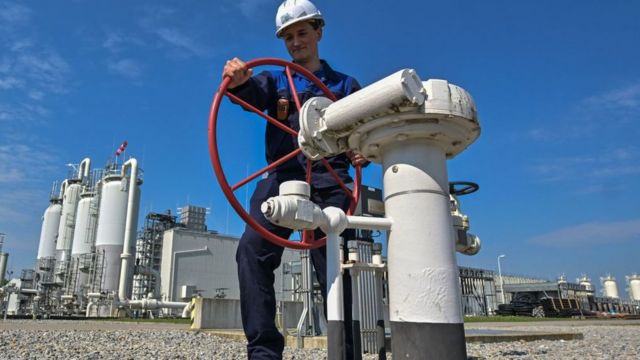The BBC News Russian Service app is available for IOS and Android . You can also subscribe to our Telegram channel.

image copyrightAFP
Europe is still assessing the consequences of the Ukrainian step
Ukraine, as it had warned the day before, stopped on Wednesday morning the transit of Russian gas to Europe through one of the branches of the pipeline due to the loss of control over the compressor station in the Luhansk region after the Russian invasion.
As a result, Gazprom will lose a third of transit capacity in Ukraine, but it has other pipelines to bypass, so that if desired, total transit to its largest European market can be reduced by no more than a few percent.
This desire is questionable, since the Russian monopoly was cutting supplies to Europe even before Vladimir Putin’s decision to send an army to Ukraine, and with the start of the bombing, Russia and the EU switched to an open energy war.
Putin demanded to pay for gas to an account in the Russian “Gazprombank” with the subsequent mandatory conversion of euros into rubles, and turned off the gas to refuseniks in Poland and Bulgaria. The EU, for its part, has abandoned coal purchases from Russia, has almost agreed to an embargo on Russian oil , and intends to reduce Russian gas purchases by two-thirds by the end of the year.
So far, Ukraine has not participated in this energy war, and the transit of Gazprom through its territory to the EU only increased with the beginning of the invasion. But now she fired the first volley.
The day before, the Ukrainian state operator of the gas transmission system announced that it was stopping transit through the Sohranivka gas distribution point and the Novopskov compressor station in the Lugansk region, as it had lost control over them. He declared force majeure.
“As a result of the military aggression of the Russian Federation against Ukraine, a number of facilities of the gas transmission system are located on the territory controlled by Russian troops and the occupation administration,” the operator said .
“The intervention of the occupying forces in technological processes, changes in the operating modes of GTS facilities, including unauthorized gas withdrawals from the transit flow, jeopardized the stability and security of the entire Ukrainian gas transportation system,” the report said.
The Ukrainians offered Gazprom to temporarily transfer transit to the north, to another checkpoint, Sudzha, which remains under Ukrainian control. Here’s how everything looks on the operator’s map (the numbers are the maximum daily transit volume in million cubic meters):
image copyrightGTS Ukraine
Gazprom replied that it was impossible to redirect flows through Sudzha and that it “did not receive any confirmation of the force majeure circumstances and does not see any obstacles for continuing to work as before.”
“Ukrainian specialists have been quietly working at the Sokhranivka GIS and the Novopskov compressor station all this time and continue to do so, transit through Sokhranivka was provided in full, there were no complaints from counterparties, and there are none,” Gazprom said in a statement. .
“The transfer of volumes to the Sudzha GIS, based on the Russian flow scheme, is technologically impossible,” the Russian concern said.
Russia and Ukraine have been arguing for decades over gas transit, and during that time the Kremlin has actively built bypassing gas pipelines to Europe – through Turkey in the south and along the bottom of the Baltic Sea to Germany in the north.
Gazprom signed the last transit contract with Ukraine for 5 years in December 2019. According to it, pumping volumes were reduced to 65 billion cubic meters in 2020 and 40 billion per year in 2021-24 – much lower than the 94 billion pumped in 2017, for example.
According to data from traders and hubs cited by Reuters, S&P Global and ICIS, on Wednesday transit through Sokhranivka fell from the usual 24 million cubic meters per day to zero.
This is a small loss: in recent days, the total volume of deliveries from Russia to Europe amounted to about 300 million cubic meters per day. In addition, transit through Sudzha increased by about 8 million to 77 million cubic meters on Wednesday. Supplies via Nord Stream to Germany remained unchanged.





